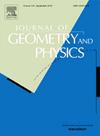Field theory via higher geometry I: Smooth sets of fields
IF 1.6
3区 数学
Q1 MATHEMATICS
引用次数: 0
Abstract
Most modern theoretical considerations of the physical world suggest that nature is at a minimum: (1) field-theoretic, (2) smooth, (3) local, (4) gauged, (5) containing fermions, and last but not least: (6) non-perturbative. Tautologous as this may sound to experts of the field, it is remarkable that the mathematical notion of geometry which reflects all of these aspects – namely, as we will explain: “supergeometric homotopy theory” – has received little attention even by mathematicians and remains unknown to most physicists. Elaborate algebraic machinery is known for perturbative field theories both at the classical and quantum level, but in order to tackle the deep open questions of the subject, these will need to be lifted to a global geometry of physics. Prior to considering any notion of non-perturbative quantization procedure, by necessity, this must first be accomplished at the classical and pre-quantum level.
Our aim in this series is, first, to introduce inclined physicists to this theory, second to fill mathematical gaps in the existing literature, and finally to rigorously develop the full power of supergeometric homotopy theory and apply it to the analysis of fermionic (not necessarily super-symmetric) field theories. Secondarily, this will also lead to a streamlined and rigorous perspective of the type that we hope would also be desirable to mathematicians.
In this first part, we explain how classical bosonic Lagrangian field theory (variational Euler-Lagrange theory) finds a natural home in the “topos of smooth sets”, thereby neatly setting the scene for the higher supergeometry discussed in later parts of the series. This introductory material will be largely known to a few experts but has never been comprehensively laid out before. A key technical point we make is to regard jet bundle geometry systematically in smooth sets instead of just its subcategories of diffeological spaces or even Fréchet manifolds – or worse simply as a formal object. Besides being more transparent and powerful, it is only on this backdrop that a reasonable supergeometric jet geometry exists, needed for satisfactory discussion of any field theory with fermions.
求助全文
约1分钟内获得全文
求助全文
来源期刊

Journal of Geometry and Physics
物理-物理:数学物理
CiteScore
2.90
自引率
6.70%
发文量
205
审稿时长
64 days
期刊介绍:
The Journal of Geometry and Physics is an International Journal in Mathematical Physics. The Journal stimulates the interaction between geometry and physics by publishing primary research, feature and review articles which are of common interest to practitioners in both fields.
The Journal of Geometry and Physics now also accepts Letters, allowing for rapid dissemination of outstanding results in the field of geometry and physics. Letters should not exceed a maximum of five printed journal pages (or contain a maximum of 5000 words) and should contain novel, cutting edge results that are of broad interest to the mathematical physics community. Only Letters which are expected to make a significant addition to the literature in the field will be considered.
The Journal covers the following areas of research:
Methods of:
• Algebraic and Differential Topology
• Algebraic Geometry
• Real and Complex Differential Geometry
• Riemannian Manifolds
• Symplectic Geometry
• Global Analysis, Analysis on Manifolds
• Geometric Theory of Differential Equations
• Geometric Control Theory
• Lie Groups and Lie Algebras
• Supermanifolds and Supergroups
• Discrete Geometry
• Spinors and Twistors
Applications to:
• Strings and Superstrings
• Noncommutative Topology and Geometry
• Quantum Groups
• Geometric Methods in Statistics and Probability
• Geometry Approaches to Thermodynamics
• Classical and Quantum Dynamical Systems
• Classical and Quantum Integrable Systems
• Classical and Quantum Mechanics
• Classical and Quantum Field Theory
• General Relativity
• Quantum Information
• Quantum Gravity
 求助内容:
求助内容: 应助结果提醒方式:
应助结果提醒方式:


